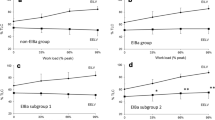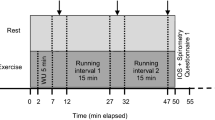Abstract
This study determined if the degree of exercise-induced refractoriness is determined by the degree of exercise-induced bronchoconstriction. In 12 patients with exercise-induced asthma (mean [SEM] age 27 [3] years) we performed 2 pairs of exercise challenges 45 min apart at different work loads on 2 days. Mean (SEM) total respiratory heat loss during low and high work loads was 3.4 (0.2) and 5.1 (0.4) kcal, respectively. After the first and second exercise challenge at low work loads, mean (SEM) SRaw increased by 107 (15) and 73 (16)% (n.s.), as compared to 361 (40) and 98 (25)% at high work loads (p < 0.005). We found a correlation between the initial airways response and refractoriness (r = 0.58, p < 0.005) and conclude that the degree of refractoriness after exercise-induced bronchoconstriction is in part dependent on the severity of exercise-induced bronchoconstriction.
Similar content being viewed by others
References
Aalderen WM van, Postma DS, Koeter GH, Knol K (1989) Circadian change in bronchial responsiveness and airflow obstruction in asthmatic children. Thorax 44:803–807
Anderson SD (1985) Issues in exercise-induced asthma. J Allergy Clin Immunol 76:763–772
Barnes PJ, Brown MJ (1981) Venous plasma histamine in exercise and hyperventilation-induced asthma in man. Clin Sci 61:159–162
Barnes P, Brown M, Silverman M, Dollery C (1981) Circulating catecholamines in exercise-and hyperventilation-induced asthma. Thorax 30:435–440
Ben-Dov I, Bar-Yishay E, Godfrey S (1982) Refractory period after exercise-induced asthma unexplained by respiratory heat loss. Am Rev Respir Dis 125:530–534
Bonnet R, Jörres R, Heitmann U, Magnussen H (1991) Circadian rhythm in airway responsiveness and airway tone in patients with mild asthma. J Appl Physiol, 71:1598–1605
Deal EC Jr, McFadden ER Jr, Ingram RH Jr, Strauss RH, Jaeger JJ (1979) Role of respiratory heat exchange in production of exercise-induced asthma. J Appl Physiol 46:467–475
Dosani R, van Loon GR, Burki NK (1987) The relationship between exercise-induced asthma and plasma catecholamines. Am Rev Respir Dis 136:973–978
DuBois AB, Botelho SY, Comroe JH Jr (1956) A new method for measuring airway resistance in man using a body plethysmograph: values in normal subjects and patients with respiratory diseases. J Clin Invest 35:327–335
Edmunds A, Tooley M, Godfrey S (1978) The refractory period after exercise-induced asthma: the duration and relation to the severity of exercise. Am Rev Respir Dis 117:247–254
Gelb AF, Tashkin DP, Epstein JD, Gong H Jr, Zamel N (1985) Exercise-induced bronchodilation in asthma. Chest 87:196–201
Gilbert IA, Fouke JM, McFadden ER (1987) Heat and water flux in the intrathoracic airways and exercise-induced asthma. J Appl Physiol 63:1681–1691
Gilbert IA, Fouke JM, McFadden ER (1990) The effect of repetitive exercise on airway temperatures. Am Rev Respir Dis 142:826–831
Godfrey S, Silverman M, Anderson SD (1973) Problems of interpreting exercise-induced asthma. J Allergy Clin Immunol 52:199–202
Hahn AG, Nogrady SG, McTumilty D, Lawrence SR, Morton AR (1984) Histamine reactivity during the refractory period after exercise induced asthma. Thorax 39:919–923
Hamielec CM, Manning PJ, O'Byrne PM (1988) Exercise refractoriness after histamine inhalation in asthmatic subjects. Am Rev Respir Dis 138:794–798
Henriksen JM, Dahl R (1983) Effects of inhaled budesonide alone in combination with low-dose terbutaline in children with exercise-induced asthma. Am Rev Respir Dis 128:993–997
James L, Faciane J, Sly RM (1976) Effect of treadmill exercise on asthmatic children. J Allergy Clin Immunol 57:408–416
Lee T, Nagakura T, Cromwell O, Brown M, Causon R, Kay A (1984) Neutrophil chemotactic activity and histamine in atopic and nonatopic subjects after exercise-induced asthma. Am Rev Respir Dis 129:409–412
Magnussen H, Scheidt-Mackes M, Kesseler KH (1983) Körperliche Belastung und Hyperventilation als auslösende Faktoren der Atemwegsobstruktion beim Asthma bronchiale. Prax Klin Pneumol 37:685–686
Magnussen H, Reuss G, Jörres R (1986) Airway response to methacholine during exercise induced refractoriness in asthma. Thorax 41:667–670
Magnussen H, Reuss G, Jörres R (1988) Methylxanthines inhibit exercise-induced bronchoconstriction at low serum theophylline concentration and in a dose-dependent fashion. J Allergy Clin Immunol 81:531–537
Margolskee DJ, Bigby BG, Boushey HA (1988) Indomethacin blocks airway tolerance to repetitive exercise but not to eucapnic hyperpnea in asthmatic subjects.Am Rev Respir Dis 137:842–846
Martin RJ, Cicutto LC, Ballard RD (1990) Factors related to the nocturnal worsening of asthma. Am Rev Respir Dis 141:33–38
McFadden ER Jr, Lenner KAM, Strohl KP (1986) Postexertional airway rewarming and thermally induced asthma. J Clin Invest 78:18–25
McNeill RS, Nairn JR, Millar JS, Ingram CG (1965) Exercise-induced asthma. Q J Med 35:55–67
Novisky N, Bar-Yishay E, Gur I, Godfrey S (1988) Respiratory heat/water loss alone does not determine the severity of exercise-induced asthma. Eur Respir J 1:253–256
Nowak D, Kuziek G, Jörres R, Magnussen H (1991) Comparison of refractoriness after exercise-and hyperventilation-induced asthma. Lung 169:57–67
O'Byrne PM, Jones GL (1986) The effect of indomethacin on exercise-induced bronchoconstriction and refractoriness after exercise. Am Rev Respir Dis 134:69–72
Reiff DB, Choudry NB, Pride NB, Ind PW (1989) The effect of prolonged submaximal warmup exercise on exercise-induced asthma. Am Rev Respir Dis 139:479–484
Sachs L (1984) Angewandte Statistik.Berlin: Springer, 6th ed.
Schnall RP, Landau LI (1980) Protective effect of repeated short sprints in exercise-induced asthma. Thorax 35:828–832
Schoeffel RE, Anderson SD, Gillam I, Lindsay DA (1980) Multiple exercise and histamine challenges in asthmatic patients. Thorax 35:164–170
Stearns DR, McFadden ER, Breslin FJ, Ingram RH (1981) Reanalysis of the refractory period in exertional asthma. J Appl Physiol 50:503–508
Wilson BA, Bar-Or O, Seed L (1990) Effects of humid air breathing during arm or treadmill exercise on exercise-induced bronchoconstriction and refractoriness. Am Rev Respir Dis 142:349–352
Author information
Authors and Affiliations
Additional information
Offprint requests to: H. Magnussen
Rights and permissions
About this article
Cite this article
Nowak, D., Jörres, R. & Magnussen, H. Influence of exercise-induced bronchoconstriction on refractoriness. Lung 170, 75–84 (1992). https://doi.org/10.1007/BF00175979
Accepted:
Issue Date:
DOI: https://doi.org/10.1007/BF00175979




